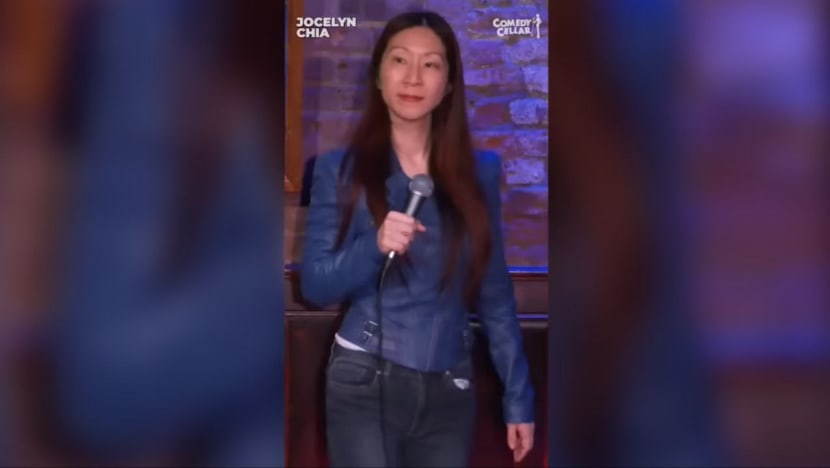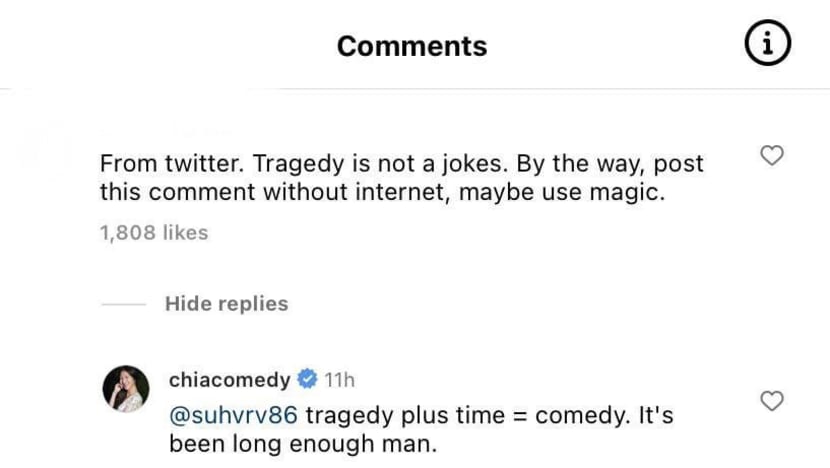Commentary: Are there lines that shouldn’t be crossed when it comes to stand-up comedy?
US-based comedian Jocelyn Chia received backlash recently for jokes made about Singapore’s relationship with Malaysia and the 2014 disappearance of Malaysia Airlines flight MH370. Actor-comedian Rishi Budhrani gives his take.

A screengrab from a performance by comedian Jocelyn Chia.
SINGAPORE: Getting to the punchline, without crossing the proverbial line, is almost like a circus trick that comedians all over the world are constantly trying to master.
Jocelyn Chia - a US-based comedian who made jokes about Singapore’s relationship with Malaysia and the 2014 disappearance of Malaysia Airlines flight MH370 - is getting backlash for her punchlines.
How did a comedy routine, performed in Greenwich Village of New York City, prompt an apology from the Minister for Foreign Affairs of Singapore, and cause a protest outside the United States Embassy in Kuala Lumpur?
In my 12 years of stand-up comedy, I’ve been fortunate to do a late-night open mic spot at The Comedy Store in Los Angeles, and also host the National Day Parade for 25,000 at The Float at Marina Bay in Singapore last year.
Along the way, I’ve learnt some things about this art form that I truly love. While I’m a work-in-progress, just like my comedy, there are some bridges I’ve crossed and experiences I’ve had that may help to understand what happened in the Jocelyn Chia incident.

THE FOUR ELEMENTS OF COMEDY
When it comes to stand-up comedy, there are four elements that play a major role. Three of these are obvious, and one, less so.
First, the comedian. Arguably the most crucial piece of the entire puzzle, this person is the writer, director and performer of the work, and a lot of the success of the performance rests on their shoulders.
Second, the content. You think of a premise, you have an experience that affects you in a certain way or you read something that inspires you, and you write these thoughts down, with some set-ups and hopefully, some punchlines. You then craft these into a set and take it to an open mic night to test it out.
Third, the audience. At these open mic nights, you see how the audience responds. If you’re getting the laughs, or the feedback you’re aiming for, you keep the jokes. If not, you try another angle, another line, another word, or another premise altogether.
You do this until you get your tight five minutes, and then 10 minutes. You work your way up to your hour and hopefully, there are enough people around the world who want to watch this show. Once you think enough people have seen it, or you are ready to tackle a different set of topics, you repeat the process from scratch.
The aim is to be able to say what you want to say and tell the jokes you want, while making your audience laugh.
I can’t speak for the entire comedy community, but this is my process and that of a lot of comedians I have known and worked with for the past decade.
The true complexity comes with the fourth element - the medium.
Stand-up comedy is meant to be an art form enjoyed “live”. Whether it’s watched online or on television, part of the unique experience is hearing the laughter of the audience in the room at the time of recording. During the show, the audience is almost like a supporting cast member.
There’s also trust. Time is spent building a relationship with the audience during a live segment. During the process, the comedian reads the room, gauges what that group of strangers, in that moment and in that space, is ready for. A form of trust is built, and in their own way, the comedian gets the audience’s permission to take them on a journey.
These topics can range from the most banal to the bizarre, from the personal to political, from the trendy to the tragic.
THE LONG AND SHORT OF IT
When an excerpt of a comedian’s routine is posted onto social media – as Jocelyn did when she uploaded a clip of one of her routines on her now-deleted Instagram page - the audience is no longer that same group of people in that room.
It might not even be the same demographic of audience she had been testing her material on. Now, her audience is the entire world wide web.
The stakes have changed. And more importantly, the rules have changed.
The rules surrounding content - official or perceived - are different for different media platforms. This is true not just for Singapore, but for countries all over the world.
Putting the merits of the jokes and the performance aside, as these are incredibly subjective, what is it that went wrong here?
Jocelyn has been reported as saying by CNN that she has told the Malaysia joke “more than a hundred times” over a year and a half without any issue for a comedy club audience in New York City. But when the segment was posted online, it was extremely poorly received by an audience on the other side of the world.
Stand-up comedian Jocelyn Chia has gone viral for the wrong reasons. Listen to comedian Rishi Budhrani weigh in on the incident:
THE BACKLASH
Viewers have every right to dislike and disagree with the content posted. Apologies by Singapore’s Foreign Minister Vivian Balakrishnan and Singapore's High Commissioner to Malaysia Vanu Gopala Menon are also an understandable step, given the highly sensitive ties between Singapore and Malaysia.
However, vilification, cancel culture, hate speech, death threats, doxxing and online bullying aimed at anyone, is not something I agree with.
Censorship is a term comedians truly detest. The last thing any performer wants to be told is what they can or cannot say. Part of the excitement of watching a stand-up comedy show is that the performer keeps you on the edge of your seat, literally and figuratively, creating tension with their routines, and allowing the audience to have some form of cathartic release with laughter.
Comedians flirt with the line of what is acceptable, and sometimes, get really close to it without crossing it. They take the risk of bringing audiences to places they may not otherwise go. It’s not easy and sometimes, comedians get it wrong.
Part of getting good at the craft is learning which jokes work with which audience members, how to approach difficult topics, maintain a balance between freedom of expression, relevance and sensitivity of the audience you’re performing to - all while making it funny.
I was asked in an interview recently whether, based on the recent events, I would adjust my approach to comedy.
To me, stand-up comedy as an art form is like a circus trick where you jump through hoops of fire, just to get a laugh. The reality is that these hoops keep shifting. My aim is to continue working, learning and improving my craft so that I can continue jumping through those moving hoops and entertain my audiences, all while telling the jokes I wish to tell.
Rishi Budhrani is a comedian, host and actor.
















